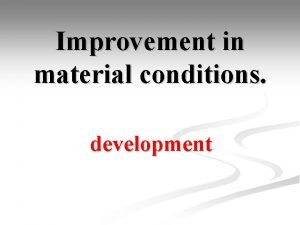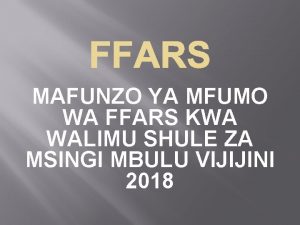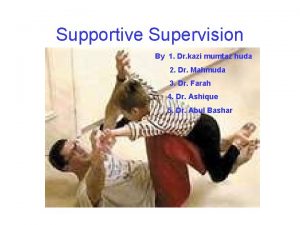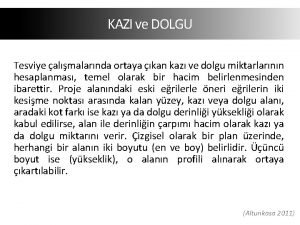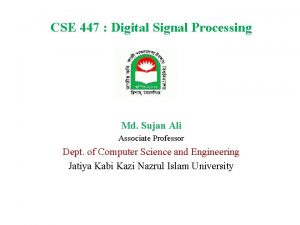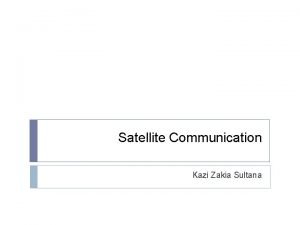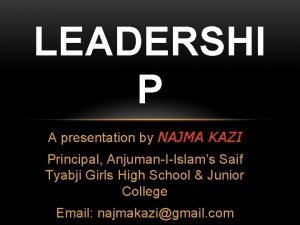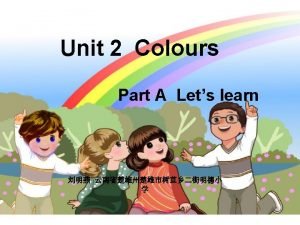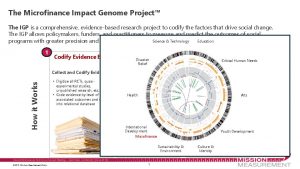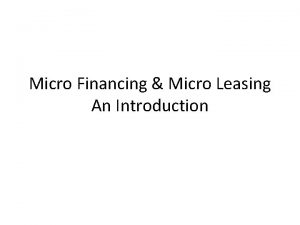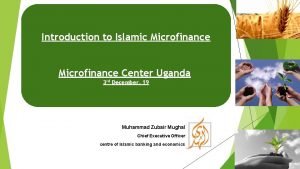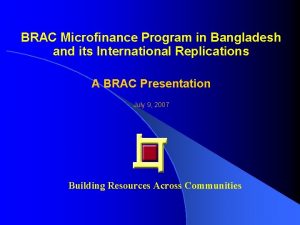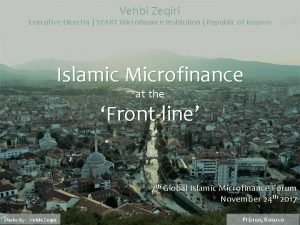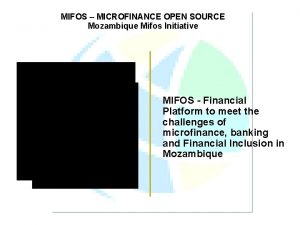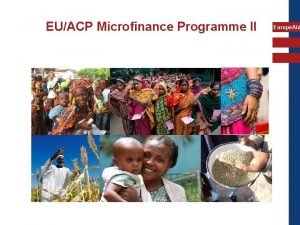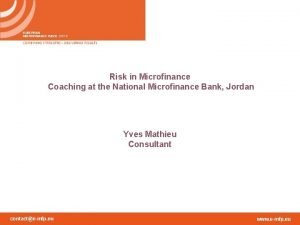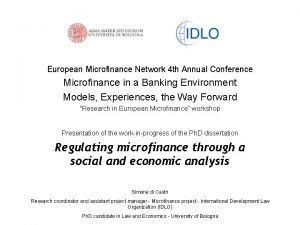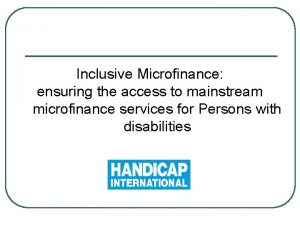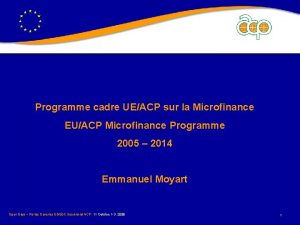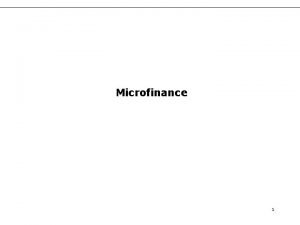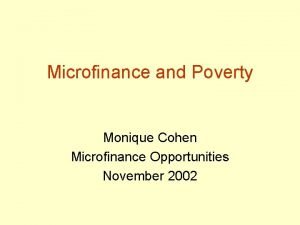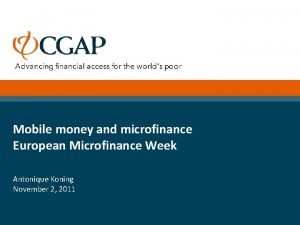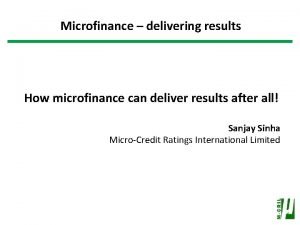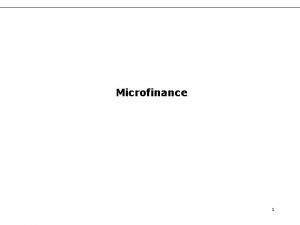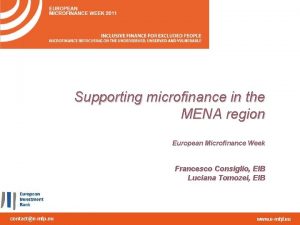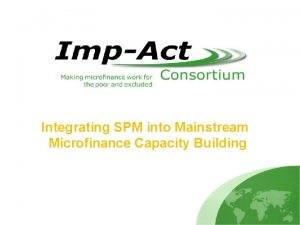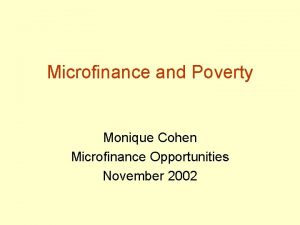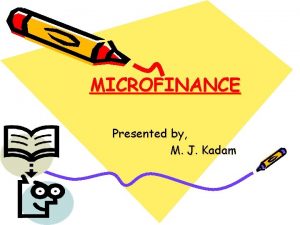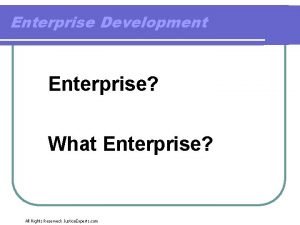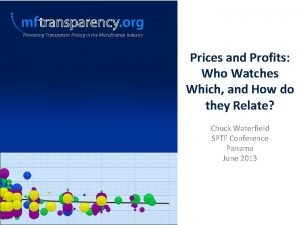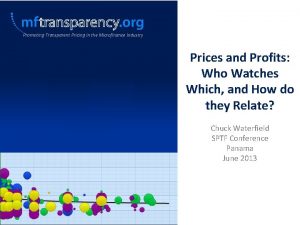Green Microfinance Promoting Green Enterprise Development Dr Kazi




















- Slides: 20

Green Microfinance Promoting Green Enterprise Development Dr. Kazi Abdur Rouf Social Economy Centre Fifth Annual ANSER Conference Sir Wilfrid Laurier University & University of Waterloo, Ontario, Canada. May 29 - June 1, 2012.

Objectives of the study • To study the operational practices of Canadian and Bangladeshi MFIs • In the area of women empowerment, poverty alleviation and community organizing To compare and contrasting of Grameen Shokti credit systems (Bangladesh) with Alterna Savings credit programs (Canada) • • To compare microfinance programs and their success/failure in these two countries • To explore which green microfinance is adopted in both countries

Green micro-credit • Green microcredit programs target micro-business owners • Engaging them in green micro-businesses • Promotes mini-cooperatives in the neighborhoods • Assist them in becoming economically self-sufficient through selfemployment • Help marginalized women entrepreneurs in their empowerment • Promote community-based local living green economy

Why Green Programs: Corporate pollution destroy environment (environmental catastrophe) • Corporate wastes and petrochemicals • • • An economics of waste and destruction Goods travel increased 20% between 1980 -2000 More packaging waste Top five oil giants profited $80 billion alone in 2008 One rule market economy Toxic products, poisoning products (Pesticides) Factory emissions are spread in the air and water $1. 18 trillion costs of carbon emissions in just one year Hazardous plants instead clean technology Destroy of forests, agro forestry and farmland

Continue • Water waste: Produce one pound beef U S uses 12, 000 gallons of water • 16 pounds of grain and soy feed for one pound beef production • Atmospheric carbon increased 40% -consequences greenhouse effect • Indoor air pollutions are increasing • Unhealthy industrial food distribution • More process foods, the less nutrition, more salt, fat and sugar, but more profit • 40% of the calories US and Canada children eat are nutritionally empty • One third of grain (most of our soya) to livestock

Continue-3 • Chemical fertilizers, hybrid seeds and chemical agriculture destroyed the soil fertility • Causes increasing of human illness and sufferings • Increasing Cancer and other diseases • Children are suffering from asthma and other diseases • Birds and animals are dying • 47 billion metric tons of carbon/year, but earth has been absorbing 50% • Corporations hold major brunt responsibility for environmental pollution: • Fossil fuel: oil, gas and coal), carbon disrupting the environment • However, Germany gets 16% of its electricity from renewable energy • 35% achieved within ten years • Cooperatives of Danish own 20% wind power

Continue • Destroy ecological harmony • Coals impact costs Americans about one-third of a trillion dollars a year • Destroy social ecology • Destroy cooperatives • Extreme power inequalities, exploitation, injustice and poverty



Green energy • One of three sources –wind, solar, bio-energy –could meet current electricity needs in the world • Wind, solar, geothermal, bio-energy and hydropower-has the technical power to provide more than sixteen times the electricity the USA needs

Micro credit needs control • Microcredit is a well known tool to address the issue of poverty • Sustainable people-centered green micro-lending program is urgent • If MFI’s are not controlled, they could involved in practicing unsafe and un-ecofriendly business financing • Effect could be unable to promote sustainable business development • Hence Green micro lending is very crucial for environmental development • To increasing the poor’s standard of living/quality of life

Research data collection • The researcher visited and studied Grameen Shokti’s Renewable Energy Project in Bangladesh in 2008 • An internship at Alterna Savings’ Community Micro Loan Funds in Toronto in 2007 -2008 • Reviewed green micro credit literatures • Participatory observations • Institutional Ethnography to study these organizations

Micro-finance institutions in Canada • Alterna Savings Toronto • Community Loan Funds Ottawa • Riverdale Community Loan Funds, Toronto • Vancity Community Banking, Vancouver • Four Corners, Vancouver • Mikiwizzi first Nations Community Development, Toronto • Rise Me Up Toronto

Alterana Savings Toronto As of December 2007, • Total active loans were 122 • Amounted to $567, 574 • Repayment rate 91 percent Loans are for businesses • • • Computer training courses Webpage designing, computer repairing and photographing Childcare, ESL learning centers, printing and grass cutting Restaurants/catering businesses Trimming grasses, cleaning services Shoe repair, tailoring and hair cutting

Grameen Shokti (GS) as of 2010 • GS is a giant in renewable energy market-based action programs in Bangladesh • Supplies affordable Solar Home Systems (SHS) to people in credit • Provides training on improved cooking stoves ( ICS), SHS and supply accessories • GS has expanded its activities to 40, 000 villages in Bangladesh • Builds bio-gas plants in the villages • Uses cow slurry, an organic fertilizer, uses for crop production

Grameen Shakti as of 2011 • Total employees is 7200 who are mostly engineers • Total unit offices is 710 • Divisional offices is 15 • Regional offices is 68 • Grameen Technological Centers is 20 • Installed 170, 000 SHS’s and 6700 ICS’s • Build 1580 biogas plants throughout Bangladesh

Results • Within the two sample cases, micro credits are positive to green development • Green microcredit-programs target micro business owners • GS supplies SHS, ICS accessories and offers training to promote green micro enterprises • Grameen in-house other organizations are involved in green development in Bangladesh too • Grameen Agricultural Foundation • Grameen Mostsha Foundation • Grameen Danone • Grameen Health • Grameen Hybrid Social Businesses

Recommendations • Canadian micro-lending organizations do not streamline enough funds for micro lending • Environment Canada can allocate resources and budgets to GMFIs • Grameen Shakti should publish its activities to share with the world • Environment Bangladesh could support NGOs for green development • Extend integrated support from public and private collaboration to promote GMFI’s and mini-cooperatives

Recommendations -continue • From Privately government to publicly accountable government • Corporations monopolized free market to freedom of al to participate n the market • From separateness to connectedness (givers/receivers) & mutual accountability • Create co-create capacity

Questions Thanks
 Japan's principal asset for promoting development was
Japan's principal asset for promoting development was Bloom taxonomy questions examples
Bloom taxonomy questions examples Kazi modo
Kazi modo Mashine sahili
Mashine sahili Ffars.
Ffars. Ambreen kazi
Ambreen kazi Supportive
Supportive Kazı ve dolgu hesaplama yöntemleri
Kazı ve dolgu hesaplama yöntemleri Cse 447
Cse 447 Idi kaži cijelom svijetu tekst
Idi kaži cijelom svijetu tekst Kazi zakia sultana
Kazi zakia sultana Najma kazi
Najma kazi Pilgrim kazı
Pilgrim kazı Rkdr
Rkdr Green green green red
Green green green red Expand igp in microfinance
Expand igp in microfinance Microfinance meaning
Microfinance meaning Islamic microfinance in uganda
Islamic microfinance in uganda Bep mis.brac.net
Bep mis.brac.net Vehbi ko
Vehbi ko Open source microfinance software
Open source microfinance software
